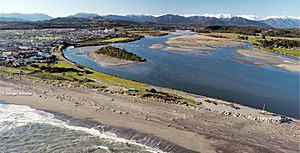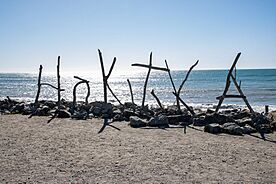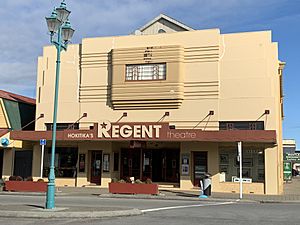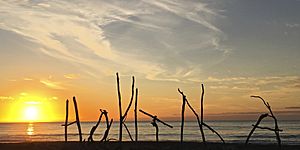Hokitika facts for kids
Quick facts for kids
Hokitika
|
|
|---|---|
|
Town
|
|

Hokitika township
|
|
| Country | New Zealand |
| Region | West Coast |
| District | Westland District |
| Ward | Hokitika |
| Settled by Europeans | 1864 |
| Electorates |
|
| Area | |
| • Total | 11.78 km2 (4.55 sq mi) |
| Population
(June 2023)
|
|
| • Total | 3,120 |
| • Density | 264.9/km2 (686.0/sq mi) |
| Time zone | UTC+12 (NZST) |
| • Summer (DST) | UTC+13 (NZDT) |
| Postcode(s) |
7810
|
| Area code(s) | 03 |
| Local iwi | Ngāi Tahu |
Hokitika is a town found on the West Coast of New Zealand's South Island. It is about 40 kilometers (25 miles) south of Greymouth. The town is located near the mouth of the Hokitika River. Hokitika is the main town and center of the Westland District. Its population is estimated to be around 3,120 as of June 2023. On a clear day, you can see Aoraki / Mount Cook from Hokitika's main street.
Contents
What Does Hokitika Mean?
The name Hokitika comes from the Māori words "hoki" (to return) and "tika" (direct). So, it means "to return directly."
The Ministry for Culture and Heritage shares a story about the name. A group of Ngāi Tahu warriors were looking for greenstone. They were planning to attack a Ngāti Wairangi village (called a pā). However, their chief drowned while trying to cross the Hokitika River. Without a leader, the taua (army) decided to return directly home.
A Quick Look at Hokitika's Past
Early Days and the Gold Rush
The land where Hokitika is today was bought from Māori in 1860. This happened when Poutini Ngāi Tahu chiefs signed the Arahura Deed. This agreement sold almost all of the West Coast region to the Crown for £300. Only small areas were kept for Māori.
Hokitika was started in 1864 because of gold mining. It quickly became a busy center during the West Coast gold rush. Many Jewish people moved there, opening stores and businesses. They even built a synagogue.
By late 1866, Hokitika was one of the biggest towns in New Zealand. On September 16, 1867, 41 ships were docked at the Hokitika wharf. Some places had three or four ships deep! In 1867, Hokitika's port was the busiest in New Zealand. It had the most ships coming in and the highest value of exports, mostly gold.
Becoming a Capital
In 1873, Hokitika became the capital of the Westland Province. This province was short-lived, lasting only until 1876. That's when provinces were removed in New Zealand.
Later History
In the early 1900s, Hokitika had two hospitals. These were the Westland Hospital and the Seaview Asylum.
The town's population has gone down a lot since the gold rush days. However, the Westland District is now seeing more people move in. Many are "lifestyle inhabitants" who enjoy the area's natural beauty. Almost 30% of the district's residents live outside Hokitika itself.
Where is Hokitika?
Climate and Weather
Hokitika has an oceanic climate. This means it has mild summers and cool winters. Rain falls evenly throughout the year. It is one of the wettest places in New Zealand. It gets over 2,800 millimeters (110 inches) of rain each year.
| Climate data for Hokitika Airport (1991–2020) | |||||||||||||
|---|---|---|---|---|---|---|---|---|---|---|---|---|---|
| Month | Jan | Feb | Mar | Apr | May | Jun | Jul | Aug | Sep | Oct | Nov | Dec | Year |
| Record high °C (°F) | 29.7 (85.5) |
28.4 (83.1) |
26.7 (80.1) |
24.5 (76.1) |
26.7 (80.1) |
18.6 (65.5) |
18.8 (65.8) |
19.8 (67.6) |
22.8 (73.0) |
24.0 (75.2) |
27.4 (81.3) |
27.1 (80.8) |
29.7 (85.5) |
| Mean daily maximum °C (°F) | 19.5 (67.1) |
19.9 (67.8) |
18.8 (65.8) |
16.6 (61.9) |
14.6 (58.3) |
12.5 (54.5) |
12.0 (53.6) |
12.6 (54.7) |
13.9 (57.0) |
14.9 (58.8) |
16.3 (61.3) |
18.2 (64.8) |
15.8 (60.4) |
| Daily mean °C (°F) | 15.8 (60.4) |
16.0 (60.8) |
14.7 (58.5) |
12.6 (54.7) |
10.6 (51.1) |
8.4 (47.1) |
7.6 (45.7) |
8.4 (47.1) |
9.9 (49.8) |
11.2 (52.2) |
12.6 (54.7) |
14.5 (58.1) |
11.9 (53.4) |
| Mean daily minimum °C (°F) | 12.0 (53.6) |
12.1 (53.8) |
10.6 (51.1) |
8.6 (47.5) |
6.5 (43.7) |
4.2 (39.6) |
3.1 (37.6) |
4.2 (39.6) |
5.9 (42.6) |
7.5 (45.5) |
8.8 (47.8) |
10.9 (51.6) |
7.9 (46.2) |
| Record low °C (°F) | 4.7 (40.5) |
3.5 (38.3) |
−0.4 (31.3) |
−0.7 (30.7) |
−2.2 (28.0) |
−3.2 (26.2) |
−4 (25) |
−2.9 (26.8) |
−2.1 (28.2) |
−1.3 (29.7) |
−0.6 (30.9) |
2.9 (37.2) |
−4 (25) |
| Average rainfall mm (inches) | 257.4 (10.13) |
191.7 (7.55) |
213.4 (8.40) |
244.9 (9.64) |
252.8 (9.95) |
261.2 (10.28) |
228.0 (8.98) |
246.9 (9.72) |
244.7 (9.63) |
284.8 (11.21) |
222.9 (8.78) |
272.1 (10.71) |
2,920.8 (114.98) |
| Average rainy days (≥ 1.0 mm) | 12.4 | 10.8 | 12.1 | 13.1 | 15.0 | 14.8 | 14.1 | 15.3 | 16.9 | 17.7 | 14.5 | 15.7 | 172.4 |
| Average relative humidity (%) | 83.8 | 87.2 | 87.1 | 85.3 | 87.8 | 87.4 | 85.4 | 85.2 | 81.7 | 84.1 | 80.9 | 82.9 | 84.9 |
| Mean monthly sunshine hours | 214.3 | 193.6 | 177.5 | 142.6 | 116.2 | 103.6 | 126.0 | 139.6 | 144.9 | 166.1 | 187.7 | 197.5 | 1,909.6 |
| Source 1: NIWA Climate Data | |||||||||||||
| Source 2: CliFlo | |||||||||||||
Hokitika Gorge
The Hokitika Gorge is a popular place for tourists to visit. It has bright blue water and a "swing" bridge. This bridge is a metal rope suspension bridge. The blue color of the water comes from something called glacial milk.
Who Lives in Hokitika?
The Hokitika urban area is about 11.78 square kilometers (4.55 sq mi). It has an estimated population of 3,120 as of June 2023. This means there are about 265 people per square kilometer.
| Historical population | ||
|---|---|---|
| Year | Pop. | ±% p.a. |
| 2006 | 3,078 | — |
| 2013 | 2,967 | −0.52% |
| 2018 | 2,892 | −0.51% |
In 2018, Hokitika had 2,892 people. There were 1,305 households. The median age was 47.5 years. About 15.9% of the people were under 15 years old.
Most people in Hokitika are European/Pākehā (86.4%). About 20.1% are Māori. Other groups include Pasifika (1.7%) and Asian (4.9%).
Many people in Hokitika (47.7%) said they had no religion. About 41.3% were Christian.
What Does Hokitika Do?
Economy and Jobs
In the past, Hokitika's main industries were pounamu (greenstone), gold, coal, and forestry. These industries have become smaller over time. However, a new industry, ecotourism, is growing. This is helping the town recover.
Hokitika is now a major stop for tourists on the West Coast's main highway. Carving greenstone is an important local business. The town is also known for its yearly Hokitika Wild Food Festival. This festival has been held since 1990.
Another important industry is dairying. Westland Milk Products has its main office and factory in Hokitika. This company started in 1937. In 2019, it was sold to the Yili Group. It is one of the largest dairy processors in New Zealand.
Arts and Culture
Hokitika has a 3D digital cinema called the Regent Theatre. This theater is an old building with an Art Deco style. It was saved from being torn down thanks to local volunteers and grants. The theater also hosts community performances. Hokitika has a drama group that puts on plays. Many artists from New Zealand and other countries also perform at the Old Lodge Theatre.
Every January, Hokitika beach holds the Driftwood and Sand Festival. People and a special artist create sculptures using things found on the beach. The festival started in 2003.
The Hokitika Museum is located in the old Carnegie library building. There is also the Hokitika Sock Machine Museum. Here, you can see old sock-knitting machines. Visitors can even try knitting their own socks! Hokitika also has a modern library and many active community groups and artists.
Marae
Arahura Marae is a marae (tribal meeting ground) located near Hokitika. It belongs to Ngāi Tahu and its Te Rūnanga o Ngāti Waewae branch. The marae includes the Tūhuru wharenui (meeting house). In 2020, the government gave money to upgrade the marae. This also helped create jobs.
How to Get Around Hokitika
Roads
State Highway 6 (State Highway 6) goes right through the town.
Trains
The first rail transport in Hokitika was a tramway in 1868. It had wooden rails and horses pulled the cars. A proper road was built in 1873.
A branch line railway called the Hokitika Branch was built from Greymouth to Hokitika in 1893. This line was extended to Ross from 1909 to 1980.
In the past, trains carried both goods and passengers to Hokitika. Passenger services stopped in 1972. Since then, the train line to Hokitika has only carried freight. Most of this freight comes from Westland Milk Products.
Shipping
After gold was found in 1865, Hokitika became an official port. It was a very busy time. Reports say over 40 ships were in the harbor at once! However, it was a dangerous port. Many ships were lost or stranded. The port became less important as the gold ran out. Hokitika remained an official entry port until the 1950s.
Air Travel
Air New Zealand offers two flights a day to Christchurch. The Hokitika Airport is very close to the town.
Hokitika was home to New Zealand's first airline, Air Travel. It carried passengers, mail, and goods. Its first flight was in December 1934. After the second world war, Air Travel became part of NAC (New Zealand National Airways Corporation).
Schools in Hokitika
A school opened in Hokitika in 1875 with almost 350 students. The Hokitika District High School taught both primary and secondary students for many years. In 1963, its name changed to Westland High School. It now teaches students from years 7 to 13.
Hokitika School is a primary school for years 1–6. St Mary's School is a Catholic school for years 1–8. It is connected to St Mary's Catholic Church. All these schools teach both boys and girls.
Famous People from Hokitika
- Agnes Addison (around 1842–1903), a Scottish businesswoman.
- Charles Button (1838–1920), a mayor of Hokitika and a politician.
- John Urquhart Cropp (1927–2016), an Olympic sailor.
- Charlie Douglas (1840–1916), a famous explorer and surveyor.
- Alice Eyton (1874–1929), a writer in Hollywood.
- Al Hunter (born 1950), a musician and singer.
- John Lazar (1840–1916), an actor and town clerk.
- Sharlotte Lucas (born 1991), a road cyclist.
- Fayne Robinson (born 1964), a Māori carver.
- Holly Robinson (born 1994), an athlete born in Hokitika.
- Richard Seddon (1845–1906), a New Zealand politician and Premier (leader of the government).
- Ebenezer Teichelmann (1859–1938), a surgeon, mountaineer, and photographer.
Important Buildings in Hokitika
- Hokitika Customhouse, built in 1897, a very old and important building.
- The Hokitika Clock Tower, built in 1902/3, a well-known landmark.
- Hokitika Museum, located in the old Carnegie Library building from 1908.
- Seaview Asylum, started in 1872, once the town's biggest employer.
- All Saints' Church, an early church made of concrete.
- St Andrew's United Church, built in 1935, a good example of a small Gothic church.
- Government Buildings (also called Seddon House), finished in 1913.
- St Mary's Catholic Church, another very important old building.
Sister City
Hokitika has one sister city:
Images for kids
See also
 In Spanish: Hokitika para niños
In Spanish: Hokitika para niños













